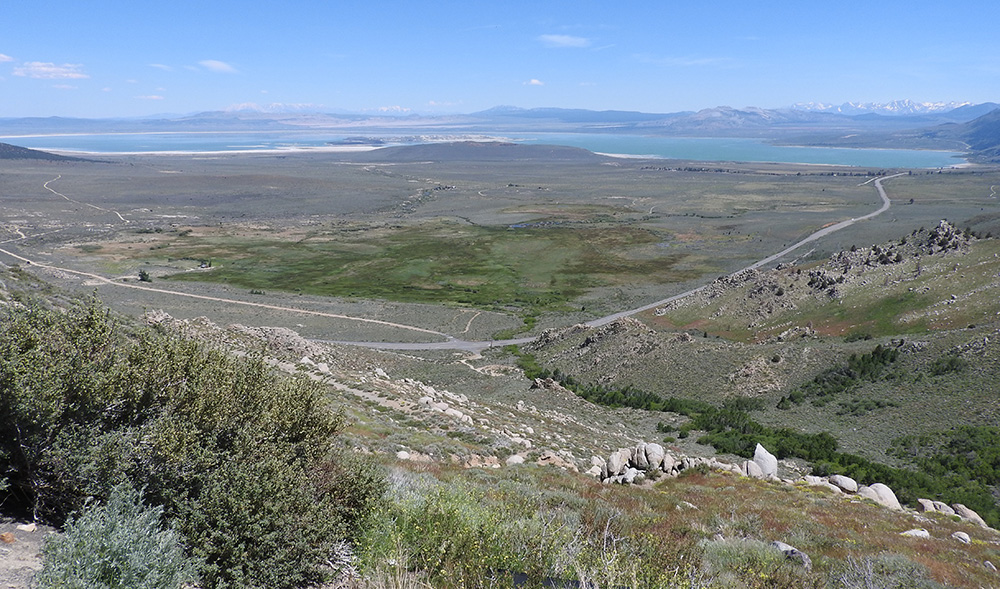
This post was written by Lisa Cutting, 2002-2020 Eastern Sierra Policy Director, 2000-2001 Environmental Resource Coordinator, and 1999 Mono Lake Intern.
Mill Creek, Mono Lake’s third-largest tributary, is unique in the Mono Basin because it was never diverted to Los Angeles. Mill Creek is also the heart of one of the Eastern Sierra’s natural treasures, Lundy Canyon, where it flows from the Sierra crest through waterfalls, fields of wildflowers, and beaver dams, into and out of Lundy Lake Reservoir, and through rare wooded wetlands before it reaches Mono Lake.

Upper Mill Creek is healthy as evidenced by streamside forests and flows consistent with other Eastern Sierra streams. But downstream of Lundy Reservoir—especially in the bottomland reaches near Mono Lake, Mill Creek has been hanging on by a thread. Over the past 40 years, more than 75% of the creek’s flow has been diverted, which means that Mill Creek has received less than half of the water it should lawfully receive according to the water rights adjudicated in 1914.
In the past, water diverted out of Mill Creek for the hydropower plant was then diverted into the Wilson diversion system, a collection of irrigation ditches and watercourses developed over the past century. Through years of a Federal Energy Regulatory Commission relicensing process for the hydropower operation, the Mono Lake Committee together with other stakeholders, has supported SCE’s efforts to improve the infrastructure needed to achieve the goal of correct distribution of water according to adjudicated water rights.
Mill Creek gets Mill Creek water
2019 marks a real highlight in Mill Creek history: Southern California Edison (SCE) is operating its Lundy hydropower plant on Mill Creek in accordance with water rights, and returning Mill Creek water back to the creek after passing it through turbines to generate power.
In the past, incorrect distribution of water due to aged infrastructure caused decades of damage on lower Mill Creek. Because the return ditch had fallen into severe disrepair it could not convey water back to Mill Creek reliably. As a result, water in excess of legal water rights could not be returned to Mill Creek and flowed down the Wilson system instead.
The water rights are clear
Mono County, BLM, and Inyo National Forest can call for their water rights to be delivered via the Wilson diversion system after that water flows through the power plant. Now that the return ditch has been repaired, all water in excess of this called-for amount is then returned through the Mill Creek return ditch.
It is important to note that putting the water back into Mill Creek is not happening at the expense of the Wilson system. Under the rule-following operation, Wilson still gets approximately 40% of Mill Creek flows.
The Committee supports SCE’s management of Mill Creek water in a manner consistent with long-established water rights, and is looking forward to the restoration benefits for lower Mill Creek, the bottomlands, and delta as well as for the overall ecological health of the Mono Basin.
For background information about this issue, click on the headlines below to read Mono Lake Newsletter articles about Mill Creek from the past ten years:
• Policy note: Mill Creek return ditch improved – 2019 Winter & Spring Newsletter
• Evidence of high flows persists on Mill Creek – 2018 Summer Newsletter
• Mill Creek return ditch passes test – 2018 Winter & Spring Newsletter
• Mill Creek return ditch tested successfully – 2017 Fall Newsletter
• More delays for Mill Creek – 2015 Fall Newsletter
• Conway Ranch easement finalized – 2015 Winter & Spring Newsletter
• North Mono Basin full of opportunity – 2014 Summer Newsletter
• Volunteers slow the spread of invasive plants along Mill Creek – 2013 Fall Newsletter
• Restoring Mill Creek – 2012 Summer Newsletter
• FERC approves Mill Creek return pipeline – 2011 Summer Newsletter
• Mill Creek losing over 75% of water to diversions – 2011 Winter & Spring Newsletter
• Anticipated restoration offers hope for Mill Creek – 2010 Summer Newsletter
• Discovering Mono Lake’s north basin wetlands – 2010 Winter & Spring Newsletter
• FERC issues ruling on Mill Creek hydropower project – 2008 Winter & Spring Newsletter
If you have questions, or would like more information, please contact Eastern Sierra Policy Director Bartshe Miller at (760) 647-6595 x142.
